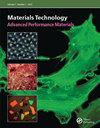Eco-friendly green synthesis of copper nanoparticles from Tinospora cordifolia leaves: optical properties with biological evaluation of anti-microbial, anti-inflammatory and anti-oxidant applications
IF 2.9
4区 材料科学
Q3 MATERIALS SCIENCE, MULTIDISCIPLINARY
引用次数: 1
Abstract
ABSTRACT The increased use of medicinal plants has raised questions regarding their safety, efficacy, and utility. Since a result, a thorough understanding of plant phytochemical components is essential, since this information will be useful in the development of innovative therapeutic medications. Copper nanoparticles (CuNPs) have received a lot of interest due to their numerous applications. The physical and chemical features of CuNPs influence their uses. In the current study, CuNPs were synthesised utilising the chemical reduction process, with Tinospora cordifolia extract serving as a reducing agent due to their high phenolic and flavonoid content and their antibacterial and anti-inflammatory properties were also assessed. The majority of the absorption peaks found in the T. cordifolia leaves extract can also be found in the FT-IR spectrum of CuNPs, often at the same locations or with just little variations in the peak’s location and intensity. Scanning Electron Microscopy (SEM) and Transmission Electron Microscopy (TEM) found that the particles were generally spherical, with an average particle size of 15 to 70 nm. Their potential as anti-bacterial and antifungal drugs was demonstrated by the antimicrobial activity, they exhibited against S. aureus (18 mm), L. bacillus (22 mm), S. mutans (24 mm), and C. albicans (15 mm). Studies on the anti-inflammatory properties of biologically produced Cu NPs were determined.环保绿色合成堇叶Tinospora cordifolia叶片铜纳米粒子:具有抗微生物、抗炎和抗氧化应用的光学特性和生物学评价
本文章由计算机程序翻译,如有差异,请以英文原文为准。
求助全文
约1分钟内获得全文
求助全文
来源期刊

Materials Technology
工程技术-材料科学:综合
CiteScore
6.00
自引率
9.70%
发文量
105
审稿时长
8.7 months
期刊介绍:
Materials Technology: Advanced Performance Materials provides an international medium for the communication of progress in the field of functional materials (advanced materials in which composition, structure and surface are functionalised to confer specific, applications-oriented properties). The focus is on materials for biomedical, electronic, photonic and energy applications. Contributions should address the physical, chemical, or engineering sciences that underpin the design and application of these materials. The scientific and engineering aspects may include processing and structural characterisation from the micro- to nanoscale to achieve specific functionality.
 求助内容:
求助内容: 应助结果提醒方式:
应助结果提醒方式:


